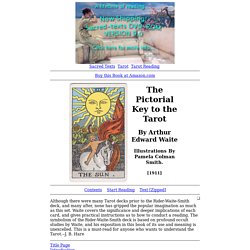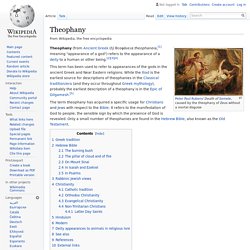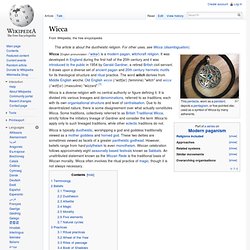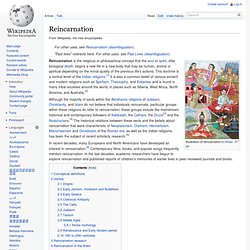

The Pictorial Key to the Tarot Index. Sacred Texts Tarot Tarot Reading Buy this Book at Amazon.com Contents Start Reading Text [Zipped] Although there were many Tarot decks prior to the Rider-Waite-Smith deck, and many after, none has gripped the popular imagination as much as this set.

Waite covers the significance and deeper implications of each card, and gives practical instructions as to how to conduct a reading. The symbolism of the Rider-Waite-Smith deck is based on profound occult studies by Waite, and his exposition in this book of its use and meaning is unexcelled. Title PageIntroductionThe Contents Part I: The Veil and its Symbols Section 1: Introductory And GeneralSection 2: Class I. Theophany. Theophany (from Ancient Greek (ἡ) θεοφάνεια theophaneia,[1] meaning "appearance of a god") refers to the appearance of a deity to a human or other being.[2][3][4] This term has been used to refer to appearances of the gods in the ancient Greek and Near Eastern religions.

While the Iliad is the earliest source for descriptions of theophanies in the Classical tradition/era (and they occur throughout Greek mythology), probably the earliest description of a theophany is in the Epic of Gilgamesh.[5] The term theophany has acquired a specific usage for Christians and Jews with respect to the Bible: It refers to the manifestation of God to people; the sensible sign by which the presence of God is revealed. Only a small number of theophanies are found in the Hebrew Bible, also known as the Old Testament. Wicca. This pentacle, worn as a pendant, depicts a pentagram, or five-pointed star, used as a symbol of Wicca by many adherents.

Wicca is a diverse religion with no central authority or figure defining it. It is divided into various lineages and denominations, referred to as traditions, each with its own organisational structure and level of centralisation. Due to its decentralized nature, there is some disagreement over what actually constitutes Wicca. Some traditions, collectively referred to as British Traditional Wicca, strictly follow the initiatory lineage of Gardner and consider the term Wicca to apply only to such lineaged traditions, while other eclectic traditions do not. Terminology[edit] Application of the word Wicca has given rise to "a great deal of disagreement and infighting".
Beliefs[edit] Beliefs vary markedly between different traditions and individual practitioners.
The Theosophical Path. Daoisim. Shinto. Reincarnation. Reincarnation is the religious or philosophical concept that the soul or spirit, after biological death, begins a new life in a new body that may be human, animal or spiritual depending on the moral quality of the previous life's actions.

This doctrine is a central tenet of the Indian religions.[1] It is also a common belief of various ancient and modern religions such as Spiritism, Theosophy, and Eckankar and is found in many tribal societies around the world, in places such as Siberia, West Africa, North America, and Australia.[2] In recent decades, many Europeans and North Americans have developed an interest in reincarnation.[6] Contemporary films, books, and popular songs frequently mention reincarnation. In the last decades, academic researchers have begun to explore reincarnation and published reports of children's memories of earlier lives in peer-reviewed journals and books. Conceptual definitions[edit] Temple door depicting Dashavatar-the ten avatars, Sree Balaji Temple, Goa. Emerald Tablet.
An imaginative 17th century depiction of the Emerald Tablet from the work of Heinrich Khunrath, 1606.

The Emerald Tablet, also known as the Smaragdine Table, or Tabula Smaragdina, is a compact and cryptic piece of Hermetica reputed to contain the secret of the prima materia and its transmutation. It was highly regarded by European alchemists as the foundation of their art and its Hermetic tradition. The original source of the Emerald Tablet is unknown. Although Hermes Trismegistus is the author named in the text, its first known appearance is in a book written in Arabic between the sixth and eighth centuries. The text was first translated into Latin in the twelfth century.
Textual history[edit] The tablet text[edit] Newton's translation[edit] A translation by Isaac Newton is found among his alchemical papers that are currently housed in King's College Library, Cambridge University.[8] Theatrum Chemicum translation[edit] Latin text[edit] Original edition of the Latin text. Influence[edit] C.G. HISTORY OF THOUGHT (PHILOSOPHY)
Meditation. Sacred Texts. Soul Contracts.